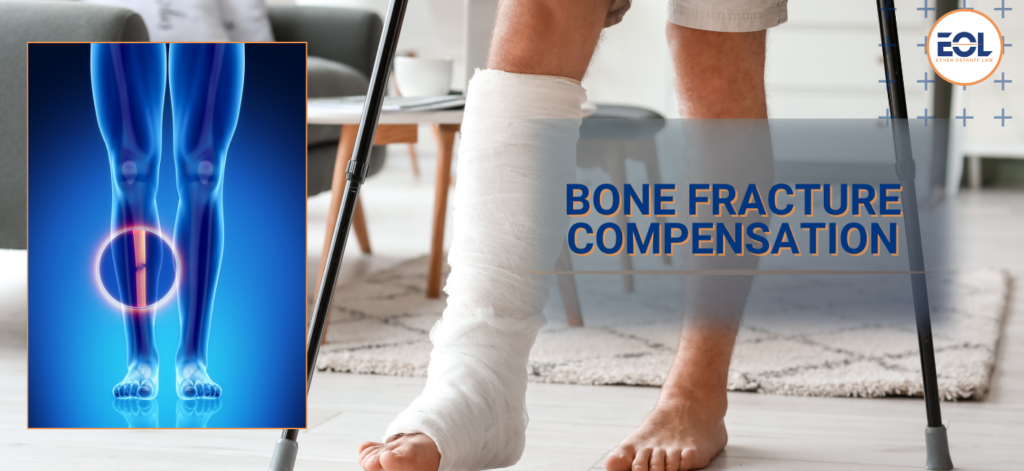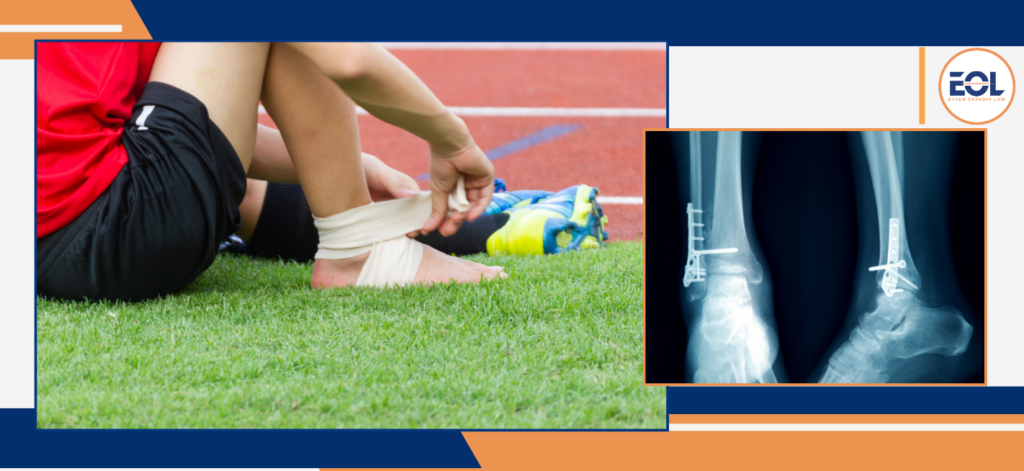How a Broken Bone Lawyer Can Help - Securing Fracture Compensation
Accidents can catch us off guard, leaving us with injuries that not only hurt physically but can also bring emotional and financial strain. Among the most common injuries are broken bones or fractures. They often result from incidents like car accidents, slips, falls, or workplace mishaps. If you’ve experienced such an injury due to an accident or someone else’s negligence, seeking assistance from a broken bone lawyer is crucial.
At Ethen Ostroff Law, we understand the challenges you’re facing and are dedicated to guiding you through the legal process while advocating for the compensation you rightfully deserve. In this guide, we cover everything you need to know about fractures and how a bone fracture attorney from Ethen Ostroff Law can secure the compensation you need for your recovery.
Fractures: What Are They?
Fractures, or broken bones, happen when a bone cracks or breaks. They can range from tiny cracks to serious breaks that poke through the skin. Affecting any bone in the body, fractures cause pain, swelling, and difficulty moving around.
Fracture Statistics in the United States
Here are the latest stats on fractures in the US:
- Around 6.3 million fractures happen annually, with a rate of 2.4 fractures per 100 people. Men tend to experience more fractures (2.8 per 100) compared to women (2.0 per 100).
- Emergency departments receive approximately 3.5 million visits for fractures every year.
- Fractures make up 16% of all musculoskeletal injuries each year.
- Women have three times higher fracture rates than men, among individuals aged 65 and older.

Exploring Fracture Types and Their Signs
Fractures vary in type, each with its own symptoms depending on where and how severe they are. Here’s a breakdown:
- Avulsion fracture: A ligament or muscle pulls on the bone, leading to a fracture.
- Comminuted fracture: Bone breaks into multiple pieces, causing intense pain, swelling, and sometimes deformity.
- Compression (crush) fracture: Typically occurs in spongy bones like the spine, resulting in vertebral collapse.
- Fracture dislocation: A joint dislocation coupled with a bone fracture.
- Greenstick fracture: Bone bends but doesn’t fully break.
- Hairline fracture: A thin, partial break causing pain, swelling, and tenderness.
- Impacted fracture: Bone fragments collide, causing pain, swelling, and tenderness.
- Intraarticular fracture: Break extends into a joint’s surface.
- Longitudinal fracture: Break runs along the bone’s length.
- Oblique fracture: An angled bone break, leading to pain, swelling, and bruising.
- Open (compound) fracture: Bone breaks through the skin, resulting in severe pain, swelling, and bleeding.
- Pathological fracture: Bone weakened by an underlying condition.
- Spiral fracture: Bone breaks in a spiral pattern, often from twisting injuries.
- Stable fracture: Bone ends align with minimal displacement, causing pain and swelling.
- Stress fracture: Resulting from repetitive stress, common among athletes.
- Transverse fracture: Horizontal bone breakage, causing pain, swelling, and bruising.
- Torus (buckle) fracture: Bone deforms but doesn’t fully crack, seen more in children, causing pain but remaining stable.
Seeking immediate medical care if a fracture is suspected is crucial to prevent complications and aid healing.
Explaining Fracture Causes
Fractures can happen due to various reasons. Here are some common causes:
- Age-related changes: Decreased bone density and muscle strength in elderly individuals increase the risk, especially from falls.
- Childhood accidents: Child abuse or play-related injuries, leading to bone fractures.
- Play-related injuries: Falls from play or sports activities.
- Medical conditions: Bone cancer, Osteogenesis imperfecta (brittle bone disease), and osteoporosis can weaken bones.
- Medical treatments or procedures: Certain medications and accidental fractures during surgery.
- Nutritional deficiencies: Lack of calcium or vitamin D weakens bones.
- Overuse or repetitive stress: From work tasks or sports activities.
- Pathological conditions: Bone cysts, tumors, or infections weakening bones.
- Trauma or accidents: Falls, motor vehicle accidents, altercations, or sports injuries.
Understanding these causes can help people take steps to prevent fractures and reduce their risk of injury.
Key Accident Types Leading to Fractures
Several accidents are particularly notable for their tendency to cause fractures. These include:
- Defective products: Malfunctioning items, like poorly designed ladders, can cause falls and fractures, holding manufacturers or sellers accountable.
- Falls: Prevalent among older adults, falls from heights or on level ground frequently lead to fractures.
- Motor vehicle accidents: High-impact collisions can result in fractures to the extremities, ribs, and spine.
- Occupational injuries: Mishaps in industries with heavy machinery or construction often lead to work-related fractures.
- Pedestrian accidents: Drivers failing to yield or striking pedestrians, resulting in injuries like fractures, may hold the driver legally accountable.
- Recreational activities: Skiing, snowboarding, and cycling can cause fractures from falls or collisions.
- Slip-and-fall accidents: Unaddressed spills or broken stairs on premises can cause slips, leading to falls and potential fractures, with property owners facing liability.
- Sports injuries: Contact sports and high-impact activities often lead to fractures.
These accidents may cause various fracture types, such as transverse, spiral, greenstick, oblique, impacted, or comminuted, determined by the force and direction of impact.

Risk Factors for Fractures
Fracture risk stems from various factors. Understanding these is key for prevention and bone health.
- Age: Fracture risk rises with age, especially in women over 45.
- Bone density: Low bone density, or osteoporosis, heightens fracture risk.
- Family history: A family history of fractures or osteoporosis increases risk.
- Gender: Men face higher fracture risks than women.
- Lifestyle: Smoking, heavy drinking, and inactivity raise fracture risk.
- Medical conditions: Diabetes, HIV, liver disease, cystic fibrosis, dementia, and Parkinson’s disease elevate fracture risk.
- Medications: Corticosteroids and anticonvulsants weaken bones, raising fracture risk.
- Nutrition: Inadequate calcium and vitamin D intake increases fracture risk.
- Trauma: Falls, accidents, and injuries from activities raise fracture risk.
Awareness of these factors is vital for reducing fracture risk through healthy habits and medical care.
Common Signs of Broken Bones
Recognizing the signs of a fracture is crucial for prompt treatment. These symptoms may include:
- Bruising: Discoloration or bruising around the injured area.
- Crepitus: Grating sensation or sound when moving the affected limb.
- Deformity: Visible misalignment or deformity of the bone.
- Limited mobility: Difficulty moving the affected limb or putting weight on it.
- Numbness or tingling: Sensations of numbness or tingling in the injured area.
- Pain: Persistent pain at the site of the injury.
- Swelling: Swelling or bruising around the injured area.
- Tenderness: Tenderness or sensitivity when touching the affected area.
Approaching Fracture Diagnosis
Diagnosing a fracture typically involves a blend of methods to precisely identify the injury and its severity. These methods include:
- Medical history: The doctor asks about the injury and associated symptoms.
- Physical examination: The doctor checks for pain, swelling, and deformity.
- Imaging tests: X-rays, CT scans, or MRI scans provide detailed images of the fracture.
Surgical Treatment Options for Fractures
The surgical treatment options for fractures depend on the severity and location. The common options include:
- Bone grafting: Bone tissue is transplanted to support healing, especially in cases of bone loss or delayed healing.
- External fixation: Pins or screws stabilize the fracture with an external frame.
- External fixator removal: The surgeon removes the external fixator frame and hardware post-healing.
- Intramedullary nailing: A metal rod inserted into the bone stabilizes it internally.
- Open reduction and internal fixation: The surgeon realigns bones and uses internal fixation devices to stabilize the fracture.
- Plating: Metal plates and screws hold the fracture in place on the bone surface.
These surgeries aim to stabilize fractures, aid healing, and restore function to the injured area.
Non-surgical Treatment for Fractures
Non-surgical treatment is preferred, when possible, based on injury severity, overall health, and healing potential. Options for fractures include:
- Bone stimulation: Electric current or ultrasound speeds bone healing.
- Braces, splints, or casts: Immobilize the limb to promote proper healing and alignment.
- External fixation: Supports and aligns the bone with an external frame.
- Immobilization or traction: Treats mild to moderate fractures.
- Medication: Prescribed to manage pain.
- Physical therapy: Restores strength and mobility post-healing.
Following doctor’s recommendations and receiving physical therapy is crucial to preventing complications.

Enhancing Recovery Time for Fractures
The duration for a fracture to heal varies based on its severity and location, spanning from weeks to months for full recovery. Adhering to the doctor’s guidance and engaging in physical therapy aids in preventing complications.
Complications and Long-Term Effects of Broken Bones
Timely medical care and suitable treatment are essential to mitigate complications and minimize the lasting effects of fractures. Discover these potential fracture complications and lasting impacts for optimal recovery:
Complications
- Chronic pain: Persistent discomfort in the healed area.
- Compartment syndrome: Swelling and pressure within muscles, requiring urgent care.
- Delayed healing: Some fractures may take longer to mend, known as delayed union.
- Infection: Risk of infection at the fracture site, particularly with open fractures.
- Loss of function: Reduced movement or strength in the injured limb.
- Malunion: Improper bone alignment during healing, leading to deformity.
- Nonunion: Failure of bones to heal despite treatment.
- Osteoarthritis: Increased likelihood of developing arthritis in the affected joint.
Long-Term Effects
- Chronic conditions: Higher risk of long-term musculoskeletal issues like arthritis.
- Disability: Permanent impairment, affecting work or quality of life in severe cases.
- Functional impairment: Difficulty with daily activities or sports participation.
- Psychological impact: Emotional distress or anxiety related to the injury and its aftermath.
- Reduced mobility: Limited movement in the affected limb due to stiffness or weakness.
Preventing Fractures from Accidents
Reducing the risk of fractures is crucial for overall well-being. Implementing practical safety measures can greatly minimize the chances of injury. Here are actionable tips:
- Be aware: Stay vigilant for hazards and uneven surfaces.
- Surface caution: Walk carefully on wet surfaces and use non-slip mats.
- Maintain good posture: Practice proper body mechanics and lifting techniques.
- Regular check-ups: Monitor bone health with your doctor.
- Safe driving: Follow traffic laws and avoid distractions.
- Safe environment: Keep walkways clear and install handrails for support.
- Stay active: Exercise regularly to improve balance and strength.
- Utilize safety gear: Wear helmets, knee pads, and seat belts during activities.
Managing a Fracture
Suffering a fracture can be distressing, but immediate action can aid recovery. Here are the essential steps to take:
- Seek medical attention: Get prompt medical help to avoid worsening the injury.
- Stabilize the injury: Immobilize the affected area with a splint or sling.
- Apply ice packs: Use ice wrapped in a cloth to reduce swelling and pain.
- Elevate the limb: Raise the injured limb to lessen swelling and boost circulation.
- Follow medical advice: Stick to the treatment plan provided by healthcare professionals.
- Rest and protect: Avoid putting weight on the injury and use supportive devices if needed.
- Monitor symptoms: Keep track of changes like increased pain or swelling and report them.
- Healthy lifestyle: Eat well, stay hydrated, and avoid smoking or excessive drinking.
- Attend follow-ups: Keep all scheduled appointments to monitor healing progress.
By acting promptly and following medical advice, recovery can be optimized, and long-term effects minimized.
Legal Options for Fractures
When someone sustains a fracture because of another party’s negligence, they have legal avenues to explore for compensation. Here are common options:
- Consultation with a bone or stress fracture lawyer: Essential for understanding legal rights and navigating compensation.
- Negligence claims: Holding negligent parties accountable for accidents like reckless driving or hazardous premises.
- Personal injury claims: Covering medical costs, lost wages, and pain and suffering.
- Premises liability claims: Seeking compensation for accidents on unsafe properties.
- Product liability claims: Holding manufacturers responsible for defective products causing accidents.
- Workers’ compensation claims: Claiming benefits for work-related fractures.
- Wrongful death claims: Family members seeking compensation for fatal accidents causing fractures.
Seeking legal guidance from a broken bones lawyer is crucial for securing rightful compensation after a fracture.
Protecting Your Rights After a Fracture
If you’ve suffered a fracture due to someone else’s negligence, safeguarding your rights is vital for seeking compensation. Here’s what to do:
- Document the incident: Collect evidence like photos, witness statements, and relevant documents.
- Seek medical attention: Get prompt medical care and keep records for evidence.
- Report the incident: Notify the appropriate authorities, such as the police or property owner.
- Preserve evidence: Keep physical evidence intact and consult your attorney before making any changes.
- Consult with a broken bone lawyer: Reach out to an experienced attorney from Ethen Ostroff Law specializing in fractures for evaluation and guidance.
- File a claim: With your broken bones attorney’s help, file a personal injury claim seeking compensation for damages.
- Negotiate or litigate: Your broken bone lawyer will negotiate with insurance companies or litigate in court for fair compensation.
- Follow legal advice: Adhere to your bone fracture attorney’s guidance to strengthen your case and assert your rights.
By taking these legal steps, you can assert your rights, hold the negligent party accountable, and secure the compensation you deserve for your fracture and related damages.
Personal Injury Compensation for Broken Bones
Compensation for broken bones encompasses various forms of damages, addressing physical, emotional, and financial impacts. Here are key components:
- Disability or impairment: Additional compensation for permanent disability or loss of function.
- Loss of consortium: Compensation for the impact on relationships.
- Lost wages: Reimbursement for income lost during recovery or disability.
- Medical expenses: Coverage for present and future medical costs.
- Pain and suffering: Compensation for physical pain and emotional distress.
- Punitive damages: Awarded in cases of egregious negligence or intentional harm.
These measures alleviate the financial burden and hardships associated with fractures. The amount is based on factors like injury severity and impact on the individual’s life.
How a Broken Fracture Attorney Can Help
A broken bone lawyer specializes in personal injury cases involving fractures, providing invaluable assistance throughout the legal process. Here’s how they support you:
- Case evaluation: Assessing circumstances, determining liability, and evaluating case strength.
- Evidence collection: Gathering crucial evidence like medical records and accident reports.
- Legal guidance: Offering expert advice on rights, options, and potential outcomes.
- Legal representation: Serving as your advocate, managing complexities, and providing peace of mind.
- Litigation: Prepared to represent your interests in court if negotiations fail.
- Maximizing compensation: Identifying avenues for full recovery, including medical expenses and lost wages.
- Negotiations: Skillfully engaging with insurance companies and adversaries for fair settlements.
Enlisting a broken bones lawyer from Ethen Ostroff Law ensures tailored legal support, enhancing your chances of securing rightful compensation for your injuries.
Contact a Broken Bone Lawyer from Ethen Ostroff Law
If you’ve suffered a broken bone or fracture due to an accident, seeking legal assistance from a qualified broken bone lawyer is crucial. At Ethen Ostroff Law, we have the experience and resources to help you recover the compensation you deserve. Contact us today at 610-510-8883 for a free consultation.
Related Questions on Broken Bones or Fractures
Q1: What is the most painful bone to break?
A1: Breaking bones can be excruciating, with certain bones causing particularly intense pain. One of the most agonizing is the femur, or thigh bone, due to its size, strength, and numerous nerves. Ribs and collarbones can also inflict significant pain as they’re near the surface and impact movement. While pain levels vary, fractures in large bones or near dense nerve clusters tend to be the most unbearable.
Q2: What type of fracture is considered traumatic?
A2: A traumatic fracture occurs when a bone undergoes sudden, forceful impact or trauma. These fractures are commonly caused by accidents, falls, sports injuries, or direct blows to the body. They typically lead to a sudden and severe break in the bone, resulting in significant pain and necessitating immediate medical attention.
Q3: Can a broken bone cause mental issues?
A3: Yes, a broken bone can sometimes trigger mental health issues. Pain, loss of mobility, and uncertainty about recovery can all contribute to feelings of anxiety, depression, or frustration. Seeking support from healthcare professionals and having a strong support network can be beneficial in managing these challenges.
Q4: How long can a broken bone go untreated?
A4: The length of time a broken bone can go untreated depends on factors like the severity of the fracture and the person’s health. Leaving a broken bone untreated can generally lead to complications such as improper healing, infection, and long-term disability. It’s crucial to seek prompt medical evaluation after sustaining a suspected fracture for proper treatment.


